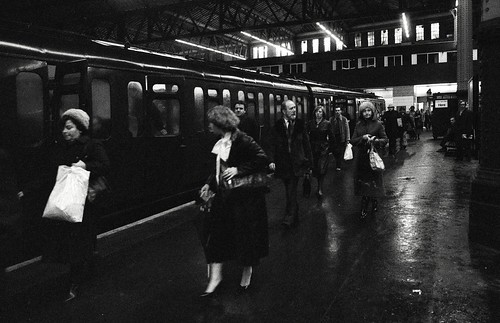
Station dwell time is the time a train stands at a station while the passengers get on and off. In the days of slam door trains (above), with ten doors on each side of the carriage, this could be less than 20 seconds. This was possible because passengers were well disciplined and closed the doors after them. Circumstances change and some time in the 1960s, the decision was made to replace slam door trains by trains with power-operated doors, a changeover that was finally completed about five years ago. One effect is that station dwell times have become a matter of concern, due to, amongst other things, the operating time of safety devices; for instance, plug doors do not open until 15 seconds after a train has come to a stand. When there are many stops on the route, the extra time builds up.
Commuter trains normally have doors at the 1:3/2:3 positions, which is intended to give better access than the alternative end-door location, but this layout has disadvantages. When bodyshells are designed on the monocoque principle, substantial reinforcement must be provided around door openings part-way along the vehicles. The vehicle itself is divided into three compartments, which restricts the options for seating layouts. It is difficult to provide intermediate doors between the entrance lobbies and the seating areas, which makes extra work for the heating and ventilation system; in the winter, seated passengers are blasted with cold air every time the doors open. Unless station platforms are fairly straight, there can be large gaps between the platform and the train. In some of the earlier designs of train such as the class 313 and 455, loading and unloading was glacially slow until the vehicle layouts were redesigned a few years ago.
Is there scope for improvement? There is a need to study precisely what happens at stations when the trains are in actual service. First, the passengers alight, and then the waiting passengers get on. The delaying factor for alighting passengers seems to be the need to take care stepping down off the train. For boarding passengers, the delay seems to be the time for those already on the train to move down inside the car, so that the queue backs-up on the platform.
If this is the case, the most useful improvements that could be made would appear to be the provision of a larger step-board to close the gap between the platform and the train, and the elimination of pinch-points inside the vehicle. These changes could mean that there are many routes where end-door vehicles could be used instead of the present 1:3/2:3 stock. There are many commuter routes where the original sliding-door fleet is approaching the end of its service life, and could therefore be replaced by newer cascaded stock presently running on longer-distance commuter services where end-door vehicles would be more suitable, provided that attention was paid to the detailed design of the doorways and the space around the entrance areas.
Kommentarer